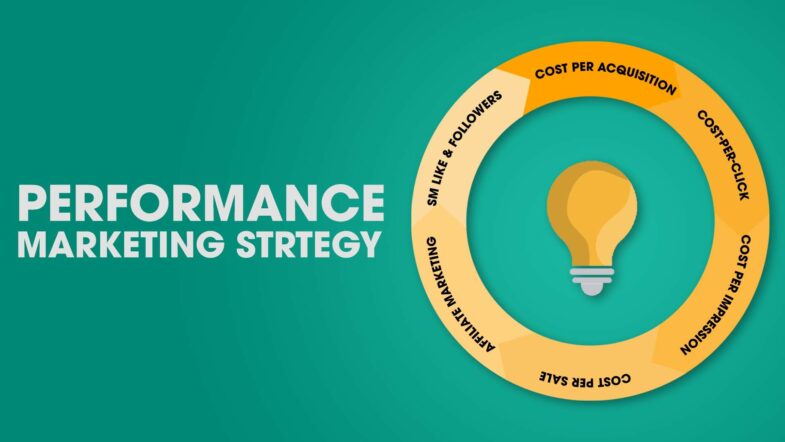Businesses must change and improve their strategies to be competitive in the continually evolving realm of digital marketing. Among the most successful strategies is performance marketing, which stresses quantifiable results and assigns responsibility. A well-thought-out performance marketing strategy depends on lead generation and ensuring that marketing initiatives quickly provide real business outcomes. Clear goals, awareness of their target market, and appropriate channel utilization support businesses in increasing the effectiveness of their campaigns.
This article offers in-depth advice on creating a successful performance marketing strategy, including developing quantifiable targets, correctly analyzing your audience, and using advanced monitoring and analytics tools. This article will help you get the most out of performance marketing and make your lead generation efforts far more successful, whether you want to start from scratch or improve your present marketing strategy.
Setting Clear Objectives
The definition of pay-per-call, which stipulates that marketers pay for each qualifying call resulting from their marketing efforts, is essential to understand. Pay-per-call, which advertisers pay publishers for approved calls their advertisements produce, is a fundamental and practical component of performance marketing.
Phonexa is an all-in-one marketing automation platform that empowers businesses to take control of their customer acquisition efforts. With its unified suite of tools covering calls, leads, clicks, email, SMS, accounting, and more, Phonexa provides a centralized hub for managing and optimizing marketing campaigns.
Data-based clear performance marketing objectives enable one always to improve these goals and assist in defining them. With this approach, businesses may rapidly modify their strategies, enhancing their return on investment and marketing performance. For marketing, pay-per-call complicates things. Businesses might significantly improve their lead generation efforts by concentrating on actions that can be tracked and utilizing smart solutions like Phonexa.
Audience Research and Segmentation
Thanks to technologies like lead generation and pay-per-call software, audience segmentation and analysis are becoming more important parts of performance marketing campaigns. Making advertising appealing to the correct target depends on marketers understanding their audience’s demography, tastes, and behavior, which these technologies help them obtain.
Performance marketing solutions improve this process by allowing you to create accurate groupings dependent on real-time data analysis. Marketing and return on investment grow by concentrating on leads most likely to become customers. Since it ensures leads are given to the appropriate sales teams or partners, boosting the chance of follow-up and conversion, the benefits of lead distribution software are particularly obvious.

Source: The Realtime Report
These tools let companies create customized experiences to grab people’s attention and motivate purchases. This top list demonstrates how creatively applying technology could cut tasks and produce certain benefits. Lead generation marketing tactics also discuss the significance of audience segmentation and analysis. Businesses may better concentrate their products and communications by applying research and client segmentation. This enables them to develop deep ties with consumers and maintain expansion in competitive marketplaces.
Choosing the Right Channels
Performance marketing and lead distribution software were developed to maximize effectiveness with pay-per-call techniques and event marketing. These tools let marketing professionals monitor calls and maximize their efforts on several outlets. Choosing channels for event marketing depends on knowing where the demographic under Target spends most of its time. These may be emails, webpages summarizing events, or social media sites.
Pay-per-call techniques explain the platforms employed depending on the audience most likely to react to discussions begun over the phone. This assures that every call is exceptional and follows the advertising objectives. This strategy largely stresses instruments for performance marketing. These technologies raise the effectiveness of the campaigns by allowing real-time alteration depending on data on the success of every channel.
Lead distribution systems also ensure that leads from several sources are quickly sent to sales teams or partners, increasing the likelihood of conversions. Carefully selecting sites based on consumer behavior and interests helps businesses boost contact and purchase activity among consumers. This assures genuine results and the success of pay-per-call campaigns and event marketing.
Crafting Compelling Campaigns
For pay-per-call marketing to be successful, programs must be designed that people desire to join. The efficacy of a campaign may be increased by using the top pay-per-call software and other innovative alternatives. These are some essential guidelines for producing effective ads:
- Understand what is pay-per-call:
Pay-per-call performance marketing pays for calls brought about by marketers’ campaigns. Our goal is to generate strong phone leads.
- State your objectives clearly:
Set promotion objectives, including calls, call quality, and conversion rate.
- Best pay-per-call software:
The best pay-per-call software will improve campaign management. These tools track, evaluate, and improve marketing calls.
- Create custom graphics and writing for your ads:
Create aesthetically pleasing advertisements and images to draw in your target market.
- Software to generate more leads:
Use lead generation software to find and follow up on leads. One will get a constant flow of quality prospects.
- You can track a phone call with:
Use call tracking software to monitor your development. This information clarifies both successful and useless approaches.
- Test and get better always:
Test headlines, calls to action, and ad placement to find what works best and then adapt.
- Review and correct:
Consistently viewing marketing data helps one monitor development and spot trends. Change your approaches to achieve and grow.
When marketers use these tools and strategies, they may design pay-per-call plans that produce leads and help their businesses grow.
Budgeting and Resource Allocation
Using performance marketing appropriately requires effectively leveraging your resources and financial situation. Businesses may boost income and achieve better outcomes with the best performance marketing software. These instruments give companies a wealth of information to select which costs would maximize return on investment.
The key to developing a successful performance marketing strategy is identifying the appropriate performance marketing channels, such as search engines, social media, and affiliate networks. Every outlet has varied capacities and targets different kinds of individuals, so it is crucial to know each one’s situation. Providing consistent solutions, tracking, and data analysis from multiple sources helps a performance marketing system concentrate resources on the areas generating the greatest results.

Source: Financial Management magazine
Good performance marketing tools let companies simplify and automate their marketing. These solutions simplify real-time bidding on advertisements, campaign management, and, more precisely, delivering adverts to every consumer. These all help raise consumer interaction and conversion rates. Constant analysis of success data and strategic adjustments based on such information enables marketers to ensure suitable use of their budgets.
Companies might use performance marketing tools and technology to maximize their resources, concentrate on the best channels, and use data to guide their marketing decisions.
Tracking and Analytics
Businesses may understand and improve their efforts using monitoring and analytics, two essential elements of every successful marketing strategy, keeping a watch on marketing projects and spotting places for improvement and demands for applying top performance marketing tools. These tools give businesses a specific understanding of customer behavior, advertising effectiveness, and general return on investment. This enables quick changes in their strategies.

Source: Visionary Marketing
Utilizing the best lead distribution software is an essential part of tracking that is successful. This tool ensures the right sales teams or agents use accurate and speedy forwarding of leads. Leads may be sent out and instantly followed up on thanks to online lead distribution software, which speeds up the process and greatly increases conversion rates. By combining tracking components, these systems offer useful data on where leads start, how effectively salespeople work, and how long leads respond.
If you want to manage the lead distribution process, you need a strong lead distribution system. Depending on variables such as region, product interest, or sales agent experience, this system might be set to assign leads automatically. Businesses might use analytics from these systems to ascertain which platforms produce the best leads and the speed and accuracy with which these leads are handled.
Companies may use performance marketing tools and lead distribution software with advanced tracking and analytics to maximize their marketing efforts, improve lead management, and boost sales.
Bottom Line
An effective performance marketing strategy requires the use of contemporary technology and data. Phone call tracking is important since it clarifies your contacts with customers and simplifies evaluating the success of your marketing campaigns. Businesses may use call monitoring analytics to track call sources, durations, and results to enhance decision-making and sales lead generation.
Using digital marketing tools and technology can help you utilize many marketing channels. Work automation, real-time data collection, and great capacity for campaign management ensure effective resource use. These components may produce a data-driven, flexible, and very successful performance marketing strategy for firms.
A performance marketing strategy must rely on technology to gather important data, improve lead handling, and raise the overall marketing effectiveness. Companies that keep correct records and use contemporary digital technology might grow and get a reasonable investment return.
Main Image Source: Tenfolds Media









